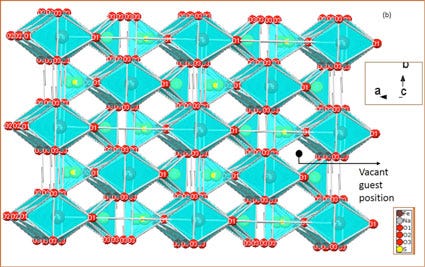A New Cathode Material Lays Groundwork for Sodium-Ion Batteries
October 5, 2015
Researchers from the University of Texas believe they have identified a novel safe and sustainable cathode material that could serve as the basic structure for the world's first commercially viable sodium-ion battery.
Kristopher Sturgis
 The new cathode material, known as eldfellite, is a nontoxic and inexpensive mineral that could be represent of the first significant strides in the push to develop sodium-ion battery technology--a low-cost alternative to the lithium-ion battery.
The new cathode material, known as eldfellite, is a nontoxic and inexpensive mineral that could be represent of the first significant strides in the push to develop sodium-ion battery technology--a low-cost alternative to the lithium-ion battery.
Lithium-ion batteries are one of the most commonly used power sources in consumer electronics, particularly in portable devices. The impact of a low-cost and energy efficient sodium-ion battery could be felt across several different industries, as they could be used to power handheld medical devices, including implants, or even power electric vehicles and energy turbines.
"No better energy solution is possible for the world than the sodium-ion battery," says Preetam Singh, a postdoctoral fellow and researcher in the Cockrell School of Engineering at the University of Texas, Austin (UT Austin) where the technology is being developed. "Sodium is a widely and almost equally distributed material across the globe. Considering the ease of distribution and cheap availability of NaCl, this is the most commercially viable energy solution."
For decades, lithium-ion batteries have been the gold standard when it comes to rechargeable battery technology, especially in portable electronic devices. Despite their high energy density and reusable traits, they continue to be limited by high production costs and the varied availability of lithium. In recent years, sodium-ion batteries have emerged as an ideal alternative, assuming that researchers can steadily improve their performance and safety.
"At this point, we're working to enhance the battery capacity, as well as enhancing the battery operation voltage, which will enhance the energy density," Singh says. "At this point, we can say that our research is going to attract more people to evaluate new materials for sodium-ion batteries, taking our structural design principle into consideration."
The structure of the new eldfellite cathode material consists of fixed sodium and iron layers that allow for sodium to be inserted and removed, all while retaining the integrity of the structure. This allows for the material to be more stable during the process of recharging, however, the team is still trying to match the energy density of the lithium-ion battery.
Creating a powerful battery remains only half the battle however, as scientists also look to develop battery technologies with fast recharge speeds. Just last year scientists from Singapore developed a new battery technology that could recharge up to 70% capacity in only two minutes. Lithium-ion batteries remain the standard in most implantable and handheld medical devices, making recharge speeds a crucial element of battery technologies--a fact that Singh and his group are well aware of.
"There are many more possibilities for this material, and the focus of material scientists, electrochemists, and the entire battery industry is now centered around the sodium-ion battery," Singh says. "I think very soon practical sodium-ion batteries will be a reality."
Learn more about cutting-edge medical devices at MD&M Philadelphia, October 7-8, 2015. |
Like what you're reading? Subscribe to our daily e-newsletter.
About the Author(s)
You May Also Like


